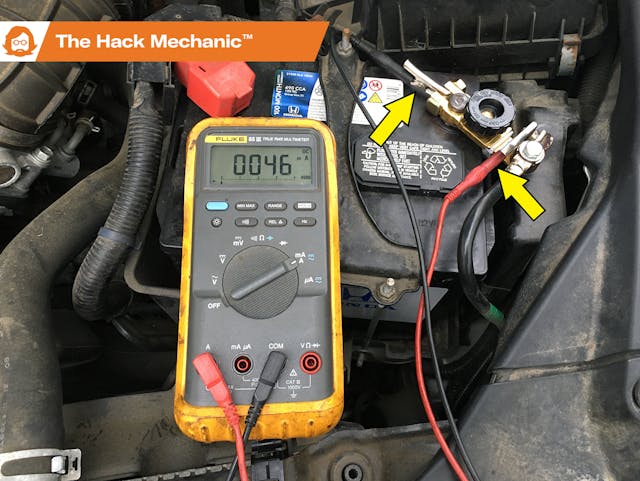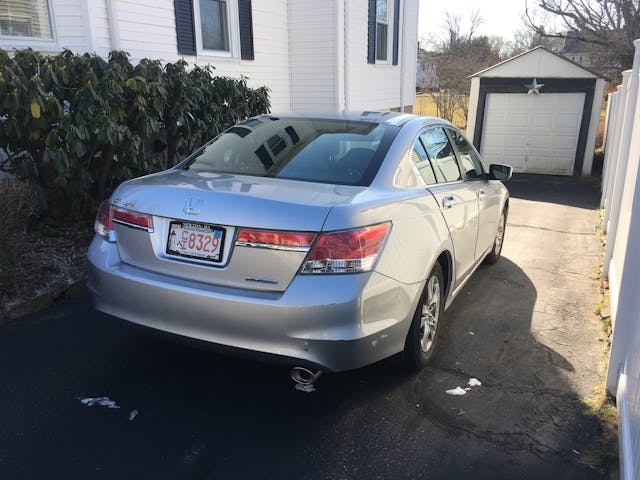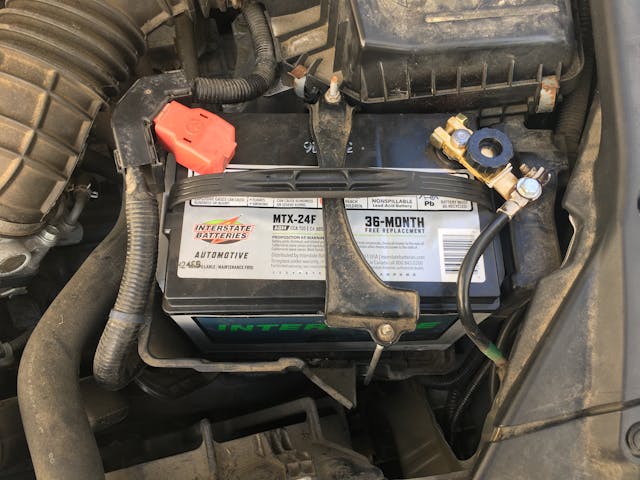Media | Articles
How to drain a car battery, starring my 95-year-old neighbor’s daily driver

My next-door neighbor Jeanette is a 95-year-old woman. She’s healthy, independent, and pretty spry for her age. And she still drives—she uses her 21,000-mile 2012 Honda Accord to go to the grocery store, the hairdresser, and to the nursing home to visit her 102-year-old brother. Unfortunately, this past fall, the car began having a problem where, after not being driven for a few days, she’d come out to drive it and find that the battery was dead.
So-called “parasitic drains”—things that run the battery down while the car is sitting—can be a problem in any car, but they’re typically worse in newer cars. The electrical systems in cars without computers and onboard diagnostics are usually very simple, so unless there’s something like an aftermarket power antenna that’s perpetually trying to go up or down, there’s very little that remains on when the key is out of the ignition. If there is a problem, the time-honored method of dealing with it is to put a multimeter set to measure amperage between the negative battery cable and the negative terminal on the battery, measure the drain, then pull fuses out until it goes away and see what devices are on that fuse. If the devices listed in the owner’s manual for the fuse all appear to be behaving, you may need to unscrew the fuse box and examine the wires being powered by the mystery fuse, as sometimes someone has wired things, shall we say, creatively. But even still, the simplicity inherent in the car’s age makes it a very tractable problem.
However, as cars crossed into the 1990s, parasitic drains became much more difficult to diagnose. They can come from many different things: heated door locks, stuck central locking actuators, alarm systems, control modules that don’t go to sleep because the microswitches on the hood, and doors don’t think they’re closed … on and on.
And finding the cause is far more difficult than on an old car. While a vintage car might have only six or 12 fuses, a modern car typically has dozens, and systems may use more than one fuse. And because you need to get the control modules to go to sleep for the current levels to drop, you have to close the doors, hood, and trunk, or at least simulate their closure by either disconnecting the switches or rolling the latches closed. Then, instead of pulling fuses, you leave them installed and check the voltage drop across the back of each fuse to infer the current passing through it. Then you need to see what systems are on that fuse, but due to the complexity of those systems, you may need to consult a wiring diagram, which on modern cars is far more complicated than the old two-page foldout and instead often takes the form of a current track diagram. Like I said, a pain.
One of the best end-to-end videos I’ve seen of a professional mechanic doing this, where he methodically diagnoses the cause of a drain on a ninth-gen Civic to be a bad door lock actuator, can be seen here:
Marketplace
Buy and sell classics with confidence
Watching it is instructive because it shows that, if the cause isn’t something simple like a dome or map light being left on (or the visor light not shutting off when its cover is flipped closed), or something laughable like an aftermarket seat heater being wired in, a comprehensive diagnosis is a beastly amount of work.
For this reason, if the drain is minor (e.g., if it drains the battery in days, not hours), many people simply live with it by either installing a battery cut-off switch or using a battery tender, maintainer, or trickle charger. As for me, I have too many cars to make trickle chargers practical (and besides, five of the cars are stored in a warehouse where there’s not easy access to electricity), so when I have cars sitting in storage for the winter, I simply disconnect the batteries. For cars that are in my driveway and driven only occasionally, I use battery cut-off switches.
Back to Jeanette’s battery-draining problem. It appeared to be getting worse; the car wouldn’t start after it had been sitting for about five days. She’d have AAA jump it. Eventually she took it to the Honda dealer. They tested the car’s two-year-old Honda-branded battery, said there was nothing wrong with it, and told her that she needs to drive the car more frequently and take it for longer drives on the highway. While there’s some truth to that, a) this is a problem that the car didn’t always have, and b) telling a 95-year-old woman who doesn’t drive on the highway that she needs to drive the car on the highway was neither terribly sensitive nor constructive. So, the battery kept running down, and she kept calling AAA. Eventually the problem happened enough that she used up her AAA benefit.
One morning she called me saying she had a hairdresser appointment in 30 minutes and the battery was dead. I checked it and found that it was down to 11.5 volts. I put it on charge and told her that, if necessary, I’d jump the car, but 30 minutes later it started. She asked, “What about if it dies when I want to drive home?” I said, “The hairdresser is two miles away. If that happens, call me and I’ll come and jump it.” (It was fine). I thought about saying, “I’ll just drive you to the hairdresser,” but you don’t mess with someone’s independence.
But the next week, she called me one morning in tears, saying that her brother had fallen in the nursing home, she needed to go see him, the car wouldn’t start, and she didn’t know what to do.
A few weeks ago, I wrote a piece about why working on other people’s cars is often a bad idea, but if I can’t help my 95-year-old neighbor out with a dead battery, I’m not, well, me. So, into the valley of the parasitic drain rode the man with the white hat.
The approach I use for this is four-fold. First, is there an obvious smoking gun? Second, is the alternator charging the battery? Third, is the battery obviously bad? Fourth, is there a measurable drain that’s above an acceptable limit?
I put a jump-pack on the battery and examined the car. I found no parking or interior lights on, and there was nothing plugged into the cigarette lighter socket (they’re not on without the key turned anyway; more on that in a moment). OK, so no smoking gun.
I jump-started the car and tested the voltage at the battery with a multimeter set to measure voltage. It read 14.3 volts, indicating that the alternator and its internal regulator were correctly charging the battery. This verified that whatever was going on wasn’t due to the alternator not charging the battery, as was the case recently with both my 2003 BMW 530i and my 1996 Winnebago Rialta.
Next, I tested the battery. I have a nifty little Cen-Tech digital battery analyzer I bought from Harbor Freight about eight years ago. There are now many similar products available on Amazon for as low as $30. These are referred to as “battery testers” or “load-testers,” but they don’t actually put a big load on the battery like an old-school carbon pile tester. Instead, they infer battery condition by conducting what’s essentially a resistance measurement across the terminals. On the Cen-Tech, if the reading is less than 5 milliohms, the battery is in very good condition. If it’s over 10, it’s toast. If it’s in the middle, it’s a gray area. I’ve found that this reading correlates well with the battery’s behavior—that is, batteries that don’t hold a charge have high resistance readings and vice versa.
I fully charged the Accord’s two-year-old Honda battery, tested it with the Cen-Tech, and found the reading to be about 6.5 milliohms—slightly higher than a new battery, but not awful. The analyzer also showed the battery to be at nearly 90 percent of its original 490 CCA capacity. So, at worst the battery was slightly weak, but there was nothing glaringly wrong with it.

With the alternator working fine and the battery not obviously bad, I took a direct current drain measurement. While you can just set a multimeter to measure amperage and put it between the negative battery post and its cable, it’s best if you do this with a $10 battery disconnect switch, as this method eliminates the big amperage surges that can come with directly connecting a multimeter and having all the current of the car’s electrical system suddenly flow through it. To do this, you:
- Install the disconnect switch on the negative side of the battery.
- Make sure the switch is engaged (is on). This forces any startup current to flow through the switch and not through the meter.
- Set the multimeter to measure DC current and connect it across the switch as shown in the photo below.
- Flip the switch to disengage it (to shut it off). This forces all current to flow through the meter, generating a reading. Remember that, in this configuration, you want to measure ONLY parasitic drain. You do NOT want to see what the drain is with lots of devices turned on, as that can easily exceed the limit of the multimeter. If the meter has a fuse, that can blow it. If it doesn’t, it can blow up the meter. WHATEVER YOU DO, DON’T TRY TO START THE CAR!
- Lock the car, as this is usually necessary to get the control modules to go to sleep.
- Watch the meter. You’ll probably see a current surge of single numbers of amps as the central locking actuates, then see it drop into the hundreds of milliamps as the interior lights wait to go out. Some amount of time later, the readings should drop into the tens of milliamps as the control modules go to sleep. This may take a few minutes or may be as long as 40 minutes. It varies by make and model. To find out what it is for your car, you may need to do some reading in a user’s forum.
In my case, within a very short amount of time after locking Jeanette’s car, the reading stabilized at a little under 50 milliamps.

If you don’t have a feel for amperage, you can convert it to the more familiar unit of watts with watts = amps x volts. The car has a 12-volt electrical system, so something drawing five amps is consuming 60 watts of power. You know what a 60-watt bulb is. Now you know that it would draw 5 amps. That’s a lot of current. In the world of parasitic drains, a drain of several amps is really big, and likely caused by something that’s actually generating heat, like an actual heater, a bright light bulb, or an electric motor. A drain of hundreds of milliamps could be something like a small bulb (a little 5-watt bulb would draw about .42 amps, or 420 milliamps), or a stuck actuator.
Now, the oft-quoted industry standard for an “acceptable” parasitic drain is 50 milliamps. So … was anything actually wrong with Jeanette’s car? It was difficult to say. It would’ve almost been preferable had I seen a much bigger drain that clearly indicated a problem.
I really wasn’t sure how to deal with it. This wasn’t my car. I didn’t have the room in my garage to do the hours of work required to try to diagnose it further, and I wasn’t certain that the thing to do was have Jeanette spend hundreds of dollars having a qualified shop chase a drain that might not be of much consequence, even if a problem existed. Yet the battery was draining sufficiently after four or five days that it caused the car not to start.
So, what followed was an odd sequence of bumping my head into the wall of why the normal workarounds appear to be to be unworkable.
I’d already installed a battery disconnect switch to enable me to properly do the drain measurement. If this were my car, that would’ve already solved the problem—I’d simply open the hood and flip the switch when I park the car in the driveway, then repeat the process when I need to drive it. But it’s simply not reasonable to expect a 95-year-old non-car-nut owner to do that.
The next obvious idea was to set her up with some sort of a battery tender or maintainer. On paper, this sounds like a slam-dunk. Unfortunately, she doesn’t park the car in her garage in the winter, as her driveway slopes slightly downhill and she doesn’t want the danger of slipping during that walk. There is an electrical outlet on the lamp post at the top of the driveway. This was what I used to charge the battery. I thought that if I set up a trickle charger there and could plug it into the Accord’s cigarette lighter socket, she’d be all set; all she’d need to do was disconnect the trickle charger from the extension cord to the lamp post.
But there was a two-fold issue with that. First, the cigarette lighter socket in the Accord isn’t active unless the key is turned to the accessories setting, so it would need to be connected to the battery instead. Like with the battery disconnect switch, I’m not going to ask her to open and close the hood whenever she needs to drive. Yes, I could permanently wire a little pigtail to the battery and have it protrude through the front grille (and I may do that, as I did with the disconnect switch, simply to make things easier on me when I help her out), but that brings us to the second problem, which is that one of the times I had the charger briefly hooked up, I watched her nearly trip over the cables. So even if she can plug and unplug a connector whenever she uses and parks the car, I’m very leery of anything that puts wires in her driveway.
Bottom line: I am not going to do anything that even slightly increases the possibility of a 95-year-old woman hurting herself. As health care professionals say, “First, do no harm.”

So, even though the battery wasn’t obviously bad, I replaced it—I got her a high-quality Interstate MTX-24F absorbed glass mat (AGM) battery with a 710 CCM rating. I’m hoping that the combination of the battery’s newness, 45 percent more capacity (at least in terms of cold cranking amps), and its AGM construction will buy the ability for to it sit for longer and behave better. At $229.95 ($242 with tax) directly from Interstate, it’s the most I’ve ever paid for a battery. (To be clear, she reimbursed me.)
[Quick digression: Costco has slightly discounted prices on Interstate batteries, and I got excited when I saw online that they offered the Costco version of this battery for $180, but on calling my local store, I learned that for some reason, Costco no longer carries Interstate AGM batteries. A web search unearthed a number of posts from folks who’ve had this same disappointment.]

A friend of mine had the interesting idea of installing a battery-charging solar panel and leaving it on the back deck under the rear windshield. The idea is that this would eliminate any driveway wires to trip over or connectors to unplug. It wouldn’t be as reliable as a trickle charger or battery tender, but any battery charging it would supply would be better than nothing. If the cigarette lighter socket was active without the key, this would be a great solution. Without that, I’d need to wire it in place, preferably directly to the battery, and I’m a bit hesitant to do that in a car that isn’t mine. But I’m thinking about it.
In the meantime, I’ll check the battery voltage weekly and see how much it’s dropping. And I’ll make some calls to find a local garage who knows how to perform proper parasitic drain diagnostics. Just in case.
Sometimes we simply wind up being responsible for certain things. Helping my 95-year-old neighbor remain independent by making sure the battery in her car stays charged isn’t a big deal to me. But as my mother used to say, what isn’t a big deal to you might be a big deal to someone else.
***
Rob’s latest book, The Best of The Hack Mechanic™: 35 years of hacks, kluges, and assorted automotive mayhem is available on Amazon here. His other seven books are available here on Amazon, or you can order personally inscribed copies from Rob’s website, www.robsiegel.com.
Check out the Hagerty Media homepage so you don’t miss a single story, or better yet, bookmark it. To get our best stories delivered right to your inbox, subscribe to our newsletters.















I had a drain problem on my 2001 Durango. Got a new battery and it still kept draining intermittently, sometimes even overnight! After days of troubleshooting fuse circuits I found no problems. That left the Central Timer Module as the only thing left. I saw a video on you tube how to troubleshoot it. My CTM module (body computer) had been acting up (flashing lights, key fobs inoperative) It shutdown in stages but never lower than 45 MA. I installed a rebuilt module, since new ones were not available even at the dealer.
Testing showed that it eventually dropped to 9 MA (.009 A ) waiting for an input to wake up. Various sites suggested that the amperage not be more that 20 MA. Problem solved for over 2 years now. Just make sure you get the exact same module for your model and options. I got the wrong module the first time and the horn and lights flashed since it was from a vehicle that had an alarm and I couldn’t turn it off! They sent a second module that has been working fine. The suggestion about 50 MA may be too high of a drain and the Body Computer itself may be at fault!
Rob, have you checked the cd player in the car. I had a cd player that wouldn’t take a cd anymore and a small motor in the player kept spinning. I meant to pull the fuse but the fusebox was in an awkward position and I had no desire to get on my back in the cold garage. And I forgot about it. Until the battery wouldn’t start the car two days later.
Years ago, my son had a Ford Escort with stereo mods, alarm, all that.
One night, the alarm went off. We checked but there was no obvious break or even an attempt to.
I suggested that he should leave the car inside, garaged. We did that, and sure enough on the middle of the night the car alarm triggered.
Having a background in electronics, i did some quick troubleshooting. No leaks to ground.
Next step, disconnected the alternator cable. There it was, a small leak thru a leaky rectifier on the alternator…The battery never drop down too much or failed to start the engine, but the alarm system was detecting the voltage drop, albeit minimal.
I read all the comments & have seen the alternator leakage, causing that issue. I have also seen battery leakage, after testing good. If you disconnect battery & 5 days later, voltage is low, 11.9- 12.3, which I have seen, replace the battery.
Took me a while to find the drain on my 87 TBird. Battery would be dead every morning. Turned out to be a bad diode in the alternator. Swapped out the alternator and the problem disappeared.
Heh. Rob will enjoy this. The worst parasitic I found was in a middle 70s BMW 530i. With the help of my trusty Fluke 87 (still going strong after around 40 years) the drain was found: a rechargeable flashlight the factory parked in the glovebox. Removed the flashlight, and all was well. A built-in Nicad bomb.
The only thing more tortuous than finding an elusive battery drain is reading this long-winded energy draining worthless rumination about the age and lifestyle of the car user along with all of the possible justifications for half-assed repairs; instead of fixing the drain on the car battery. I’m not 95, and I’ve already considered all of the half-assed repairs for the same problem with my 94 K1500. I need new inspiration on how to fix the draw, not to read a wandering editorial until I’m 95. Good topic, now get to work.
I noticed many service calls in my neighborhood during the pandemic when people weren’t driving their cars. It happened to me when we didn’t use the Mazda for a while. After sitting for months, the old Model A fired right up and got us to where we wanted to go. The A did have a current drain that began when I replaced the generator with an alternator. Since the previous owner had drilled a hole in the dashboard to the left of the steering column, I installed a toggle switch to shut off the power.
I once encountered a 2011 Honda Accord that was used in a similar manner to this one — older owner, mostly short trips, long idle periods. My solution was the same as yours: a 5W solar panel on the back deck. As of 2016, it was still working well (I’m no longer in contact with the owner).
Great article Rob.
Years ago I had the same problem with my 1984 Mercury Grand Marquis Wagon. With the amp meter in line it had a small draw, but not enough to kill the battery, yet it would die if the car wasn’t driven for a few days.
To make a long story short my Son had put a penny in the cigarette lighter that was mounted vertically in the back door. The cigarette lighter was on a self resetting circuit breaker, so the load only showed up briefly after the breaker had reset itself and drawing too much current until it tripped again.
Modern Hondas of the 4 cylinder variety have inadequately sized batteries, a group 51/24. Blame fuel economy targets, cost cutting and vehicle mass bloat. Interestingly enough, they also have logic built into the alternator exciter circuit which shuts off the alternator during daytime (headlights off) cruising. They’ll essentially cruise around at battery rest voltage, 12.5vdc or similar. Again, a fuel economy thing. Turn the headlights on, and the logic says “full power” and commands the alternator to wake up and charge again, like it should.
A v6 Accord battery, a group 35, iirc, fits in the space with a little trimming of the lower battery tray and a little tweaking of the upper hold-down. You can also swap in the v6 model’s lower tray and upper bracket, if you’re so inclined. This gives a greater RC and higher CCA, so it would potentially hold sufficient charge to start the vehicle longer between drives. Running the headlights all the time tricks the alternator into charging all the time, which also alleviates the battery going below start threshold voltage as often.
The bcm and associated alarm/locking modules take about 8 minutes to go to sleep if you don’t command the doors to lock. Makes drain testing a bit more challenging.
Just good for thought for any other similarly-affected Honda owners out there.
Hi All, I am the owner of a Toyota Cressida GLi 6 1981 Automatic Sedan and live in South Africa. Paracetic drain problem since a few months ago. Replaced battery with a new one but problem not solved. Live in a one horse town. Am 76 yr old widow who don’t have the bucks for endless tests etc to solve the problem by big auto electric firms in neighboring town. So my only solution to date is to disconnect my car and connect it again when I need to drive in my own town from point A to B. It is so frustrating. I found this thread very interesting. Regards, Poppie Oosthuizen.
The car stereo may deplete your battery if your fuse is disconnected or blown out. Even if the car stereo is not being used, a defective fuse could persistently draw electricity, eventually draining the battery.
You can find more information here: https://g0hwc.com/fix-car-stereo-draining-battery/